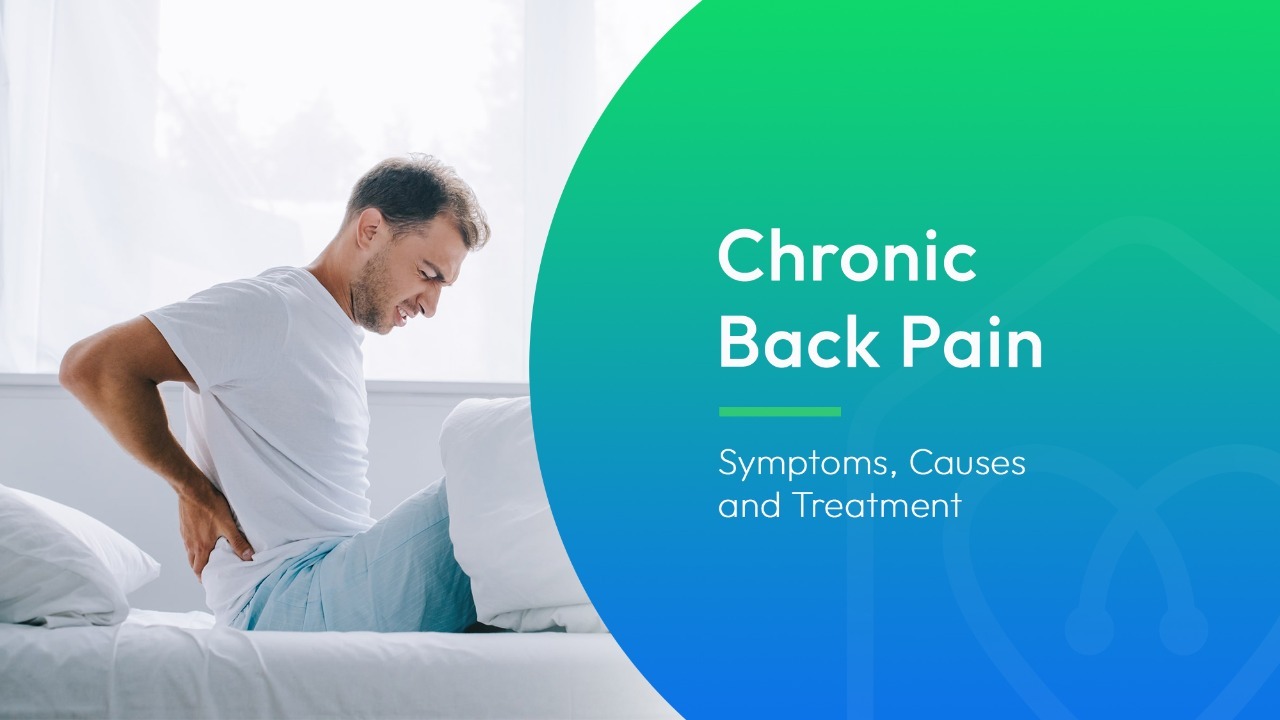What is Chronic Back Pain?
When pain in your back is constant and lasts for more than three months, it is considered to be chronic. It may not be continuous but may come and go. You may have some relief temporarily, and it could be back with a bang. Dealing with this constant discomfort can be frustrating; when you don’t know what’s causing it or how to get rid of back pain, all the more so. It is very common, and one of the leading causes of absence from work. A sizeable percentage of adults are likely to have chronic back pain at some point in their lives.
Symptoms Of Chronic Back Pain
Usually, the low back pain symptoms start slow, and stay for long – for six weeks or longer. Acute back pain differs from chronic in that it doesn’t last for more than two to six weeks. Chronic pain doesn’t heal by itself and necessitates medical intervention, and it often prevents the patient from doing any physical activity – which can worsen the pain.
Read Also: Physiotherapy Exercises For Lower Back Pain
What Causes Lower Back Pain?
It is difficult to pinpoint a single injury or condition for chronic back pain; there are often multiple lower back pain causes.
Muscular Atrophy
Muscles tend to weaken and decondition as you age; this is among the most common chronic back pain causes. The muscles in your back are no longer strong or stable enough to support you properly and become worn out. Sedentary lifestyles hasten muscular atrophy, though some of it is due to age. Prolonged inactivity leads to the weakening and shrinkage of muscles; they become incapable of supporting ligaments and vertebrae as usual. This can cause more pain, and make you increasingly vulnerable to injury.
Poor Posture or Body Mechanics
Improper posture can lay undue stress on your spine and put pressure on its surrounding soft tissue. When this happens for a prolonged period, the spine’s structural components can get eroded. The kind of work you do also has an impact on your muscles. If you’re sitting at a desk the entire day without properly stretching your muscles, your hip flexors can become tights, eventually leading to weaker hamstrings and hips, culminating in lower back pain.
Bending over your keyboard for long periods can cause spine curvature. It is essential that you sit upright. If your work necessitates a lot of lifting and carrying of heavy objects, or repetitive movement, you must employ the right posture and mechanics; overuse of muscle can also lead to chronic back pain. Incorrect sleep posture can also cause chronic lower back pain.
Genetics and Aging
It is normal for our bodies to change as we age, and aches and pains are all too common. Muscles become weaker, and spaces between spinal discs become narrow. It’s a natural ageing process; however, other conditions can speed up this process. We’ll talk about those a little further down.
Trauma
Vehicular accidents, slips, falls, and similar events can hasten spinal ageing, and cause chronic pain to intensify. In such a situation, you are likely to overcompensate with little or no movement, and this can in turn worsen the pain and muscle weakening, causing recurring back pain.
Also Read: Active vs Passive Physiotherapy Treatment
Risk Factors
While back pain is something even children can get, there are certain risk factors which increase the risk:
- Age – as you get into your 30s and 40s you are more susceptible to developing back pain
- Sedentary lifestyle – muscles that are unused get weak; unused back and abdomen muscles cause back pain
- Obesity – the extra kilos you’ve added on with poor food choices and lack of exercise, lay greater stress on your back
- Ailments – certain illnesses like cancer, arthritis, and osteoporosis can cause chronic back pain
- Psychological conditions – those with depression, or anxiety issues are more likely to develop back pain due to prolonged stress which tenses muscles
- Smoking – smokers usually have continuous coughing which can cause spinal disks to herniate; it can also reduce the blood circulation to the spine, increasing the possibility of osteoporosis.
When to See a Doctor
Living with chronic back pain is daunting and frustrating; while home treatment and self-care can be done, you should ideally see a doctor if the pain:
- Lasts for over 6 weeks
- Is severe and shows no sign of reducing with self-care
- Radiates down either or both legs, especially below your knees
- Makes legs feel weak or creates tingling sensations and numbness
- Is accompanied by unusual loss of weight
If you have any of the following symptoms, you must seek immediate medical intervention:
- Problems with your bladder or bowel
- High fever
- If you have had a bad fall or any trauma to the back
Diagnosing Back Pain
If you have chronic back pain symptoms you may want to consult a doctor. The doctor will conduct a proper physical examination and take your medical and family medical history. You will be asked about your routine, type of job, and more. The doctor may prescribe CT scans, MRIs, X-Rays or other diagnostics to get a clearer idea about the cause or source of your pain.
ALSO READ: Benefits of Getting Physiotherapy Treatment at Home
Chronic Lower Back Pain Treatment
Chronic back pain treatment necessitates a multi-disciplinary, multi-pronged approach that is capable of dealing with all facets of the problem – mental and physical – so that the patient makes a complete recovery. Initially, the patient is likely to be prescribed physiotherapy, exercises, stretches, diet changes, and so on. Our caregivers at Lana Life Care are well-trained in helping patients do the prescribed exercises. This is helpful for patients who may be otherwise not motivated or able to do them on their own. If these methods don’t deliver the desired results, medication and interventional procedures may be required.
Today techniques that are nominally invasive are available, and they are capable of significantly reducing chronic back pain when other methods fail. Steroid injections, injections to the sacroiliac joints, radio frequency ablations etc. are the main interventional procedures used in the treatment of chronic back muscle pain. RFA treatment is about transmitting heat and electricity to the nerve endings at the small spinal facet joints, and it provides long-term relief for patients with osteoarthritis and chronic back pain.
Now, differential target multiplexed spinal cord stimulation is available for chronic back pain treatment. This has the potential to transform the lives of individuals dealing with chronic pain. This therapy involves stimulating the spinal cord and blocking pain signals before they reach the brain via an implant.
Mindfulness and Meditation
Chronic back pain is not just physically exhausting but mentally as well; patients with back pain are often frustrated, irritable, and depressed. It is very important to provide emotional support to these patients and get their spirits up. Cognitive and relaxation therapies including Yoga, meditation, tai-chi, and so on may be prescribed. At Lana Life Care, our care providers can help patients with a variety of relaxation therapies to improve their emotional and mental well-being.
Diet
Foods with high sugar content, processed foods, and those with significant amounts of trans fats can increase inflammation. If the patient is consuming such foods, they need to change their food habits immediately. The caregivers at Lana Life Care can recommend diet changes and help set daily menus, and can also partner with you in your weight loss journey. Staying at your ideal weight or close to it can help reduce your back pain by easing the pressure on your spine.
Lifestyle Modifications
Chronic pain is a reminder to you to adapt to your limited mobility; you need to take breaks when you’re doing physical activities like cleaning up, carrying things, or doing laundry. Note down what makes the pain worse, and try to avoid them. You may also have to limit your alcohol intake and give up smoking altogether. It has been proven that the nicotine in tobacco delays healing and intensifies pain.
Physiotherapy For Lower Back Pain
The doctor may prescribe special chronic back pain exercises and physiotherapy for treating your pain. Each individual is different, and therefore, the exercises prescribed for each are likely to differ. They are tailored to suit your unique requirements and current health status and abilities. Lana Life Care professionals can help ensure that you do your physiotherapy and aerobics exercises, helping you with stretches, maintaining certain postures and more. Physiotherapy can also help you regain flexibility, posture, mobility, and core strength.
Trained professionals like the home nurses at Lana Life Care, who are the leading home health care service provider in UAE can show you how to deal with chronic back pain with home self-care; it is always a good idea to help the body heal on its own without medicines or procedures. At Lana Life Care, we can support the self-care treatment procedures for people with chronic back pain, and help them heal quicker. Our caregivers are trained to recognize situations which call for medical intervention or immediate physician consultation. Are you or is a loved one suffering from chronic back pain? Don’t wait – call us now to get the best care right at home.

